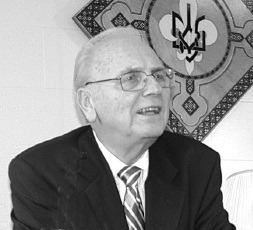TAO
Board Member Bob Myndiuk
 In
August of 2011, Bob (Bohdan) Myndiuk joined the Transport Action
Ontario Board. Born in Ukraine, Bob attended high school in Toronto,
then the University of Toronto, followed by the Ontario College
of Education. He taught accounting, business law and
economics in North York and Etobicoke secondary schools. In 1971, he
joined Cholkan Realty where he stayed for over 30 years, becoming its
President and CEO.
In
August of 2011, Bob (Bohdan) Myndiuk joined the Transport Action
Ontario Board. Born in Ukraine, Bob attended high school in Toronto,
then the University of Toronto, followed by the Ontario College
of Education. He taught accounting, business law and
economics in North York and Etobicoke secondary schools. In 1971, he
joined Cholkan Realty where he stayed for over 30 years, becoming its
President and CEO.
Bob
has been especially active in the Ukrainian community in Toronto,
serving on a variety of its non-profit boards. Recently, he was
associated with a major project at York University, funded by
the federal government, to extend professional development to
foreign and trade policy analysts in cooperation with Ukraine’s
government. For a number of years, Bob has served and still is a
director of the Canada-Ukraine Chamber of Commerce.
Urban
transit, and especially streetcars – now known as light rail
transit (LRT) - have always fascinated Bob. Over the years, he has
travelled widely in Western and Eastern Europe, South America,
Mexico, as well as in the US. He frequently focussed his travels on
cities with street railways, and has developed a worldwide
knowledge of this mode of transportation that has even led to links
to Eastern European LRT vehicle manufacturers. Bob participated
in the first wave of the tendering for new streetcars by the TTC on
behalf of the Ukrainian firm of Tatra-Yug.
Now
semi-retired, Bob tracks the rebirth of LRT across the world.
Following World War II, countries around the world shed urban
streetcar systems in favour of buses, mainly as a result of the rise
of automobile use. Even in Europe, tram systems were abandoned except
in Germany, Austria, Switzerland, Belgium. Holland and Eastern
Europe. Bob wrote a detailed article on the fall and rise of LRT for
the September 2010 newsletter of Transport Action Canada. Peaking in
1920 at 1,700 streetcar systems, the number dropped to about 300 by
1980, and now this number has doubled. Bob points out that Edmonton
started the LRT comeback in Canada in 1978, adopting the German
example of Frankfurt-am-Main. Edmonton became the model for San Diego
in the US which opened its first LRT in 1981. He mentioned that both
France and the US are now leading the way with over 20 new systems
each and more planned.
The
hallmark of modern LRT is fast and reliable service obtained by
putting track on dedicated right-of-way and stops further apart than
every city block. But so called “heritage” streetcar lines are
also returning in the form of on-street trams usually designed for
local downtown circulation. Portland, OR is one of the best examples
with its growing LRT and streetcar routes.
Asked
to comment about the world’s outstanding LRT vehicles and systems,
Bob is reluctant to provide a first choice. The low-floor Eurotram
built for the Strasbourg, France, LRT system that opened in 1994
certainly set a new standard for LRT vehicles design. However,
after
several decades of development, many high quality low-floor light
rail vehicles are on offer from multiple builders.
Bob
stressed that, because city forms vary so significantly around the
world, with all kinds of streetscapes even in any one city, the
experience of taking light rail transit is just as much about the
look and feel of the places where LRT runs as it is about LRT
technology itself. Subways may move large crowds over longer
distances quickly, but LRT gives the traveller a sense of place
and its unfolding in terms of style and function, and how it is being
used by people living and working in such places.
The
TAO Board is fortunate to have Bob available as a resource person
regarding the many benefits and advantages of bringing light
rail transit to Ontario.
[NP
– Among several Ukrainian community boards, New Pathway Publishers
Board of Directors is also fortunate to have Bohdan Myndiuk as a
board member.]
Transport
Action Ontario Newsletter – January-February 2013
PHOTO
Bohdan
Myndiuk
 In
August of 2011, Bob (Bohdan) Myndiuk joined the Transport Action
Ontario Board. Born in Ukraine, Bob attended high school in Toronto,
then the University of Toronto, followed by the Ontario College
of Education. He taught accounting, business law and
economics in North York and Etobicoke secondary schools. In 1971, he
joined Cholkan Realty where he stayed for over 30 years, becoming its
President and CEO.
In
August of 2011, Bob (Bohdan) Myndiuk joined the Transport Action
Ontario Board. Born in Ukraine, Bob attended high school in Toronto,
then the University of Toronto, followed by the Ontario College
of Education. He taught accounting, business law and
economics in North York and Etobicoke secondary schools. In 1971, he
joined Cholkan Realty where he stayed for over 30 years, becoming its
President and CEO.